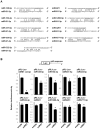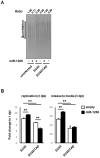SV40 miR-S1 and Cellular miR-1266 Sequester Each Other from Their Targets, Enhancing Telomerase Activity and Viral Replication
- PMID: 36005825
- PMCID: PMC9413689
- DOI: 10.3390/ncrna8040057
SV40 miR-S1 and Cellular miR-1266 Sequester Each Other from Their Targets, Enhancing Telomerase Activity and Viral Replication
Abstract
Virus-encoded microRNAs (miRNAs) target viral and host mRNAs to repress protein production from viral and host genes, and regulate viral persistence, cell transformation, and evasion of the immune system. The present study demonstrated that simian virus 40 (SV40)-encoded miRNA miR-S1 targets a cellular miRNA miR-1266 to derepress their respective target proteins, namely, T antigens (Tags) and telomerase reverse transcriptase (TERT). An in silico search for cellular miRNAs to interact with viral miR-S1 yielded nine potential miRNAs, five of which, including miR-1266, were found to interact with miR-S1 in dual-luciferase tests employing reporter plasmids containing the miRNA sequences with miR-S1. Intracellular bindings of miR-1266 to miR-S1 were also verified by the pull-down assay. These miRNAs were recruited into the Ago2-associated RNA-induced silencing complex. Intracellular coexpression of miR-S1 with miR-1266 abrogated the downregulation of TERT and decrease in telomerase activity induced by miR-1266. These effects of miR-S1 were also observed in miR-1266-expressing A549 cells infected with SV40. Moreover, the infected cells contained more Tag, replicated more viral DNA, and released more viral particles than control A549 cells infected with SV40, indicating that miR-S1-induced Tag downregulation was antagonized by miR-1266. Collectively, the present results revealed an interplay of viral and cellular miRNAs to sequester each other from their respective targets. This is a novel mechanism for viruses to manipulate the expression of viral and cellular proteins, contributing to not only viral lytic and latent replication but also cell transformation observed in viral infectious diseases including oncogenesis.
Keywords: interplay; miR-1266; miR-S1; miRNA; simian virus 40.
Conflict of interest statement
The authors declare that they have no conflict of interest.
Figures






Similar articles
-
SV40 microRNA miR-S1-3p Downregulates the Expression of T Antigens to Control Viral DNA Replication, and TNFα and IL-17F Expression.Biol Pharm Bull. 2020;43(11):1715-1728. doi: 10.1248/bpb.b20-00415. Biol Pharm Bull. 2020. PMID: 33132317
-
Functionally orthologous viral and cellular microRNAs studied by a novel dual-fluorescent reporter system.PLoS One. 2012;7(4):e36157. doi: 10.1371/journal.pone.0036157. Epub 2012 Apr 27. PLoS One. 2012. PMID: 22558366 Free PMC article.
-
Human miR-3145 inhibits influenza A viruses replication by targeting and silencing viral PB1 gene.Exp Biol Med (Maywood). 2015 Dec;240(12):1630-9. doi: 10.1177/1535370215589051. Epub 2015 Jun 15. Exp Biol Med (Maywood). 2015. PMID: 26080461 Free PMC article.
-
Regulation of the MIR155 host gene in physiological and pathological processes.Gene. 2013 Dec 10;532(1):1-12. doi: 10.1016/j.gene.2012.12.009. Epub 2012 Dec 14. Gene. 2013. PMID: 23246696 Review.
-
Viral miRNAs.Methods Mol Biol. 2011;721:43-66. doi: 10.1007/978-1-61779-037-9_3. Methods Mol Biol. 2011. PMID: 21431678 Review.
Cited by
-
Serum/glucose starvation enhances binding of miR-4745-5p and miR-6798-5p to HNRNPA1 mRNA 3'UTR: A novel method to identify miRNAs binding to mRNA 3'UTR using λN peptide-boxB sequence.Noncoding RNA Res. 2025 Jan 7;11:188-199. doi: 10.1016/j.ncrna.2025.01.001. eCollection 2025 Apr. Noncoding RNA Res. 2025. PMID: 39896348 Free PMC article.
References
LinkOut - more resources
Full Text Sources

